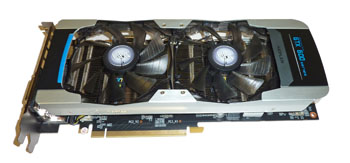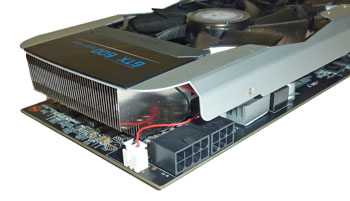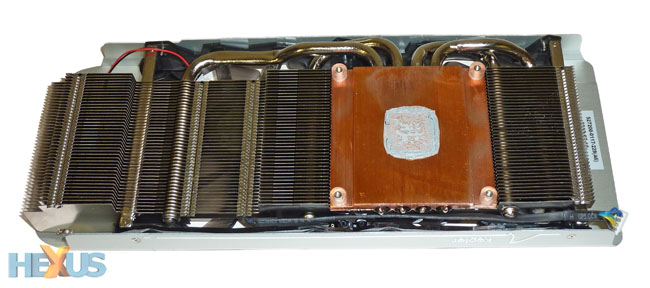Meet the KFA² GTX 660 Ti EX OC
Based on the established NVIDIA Kepler architecture and clocked in at GTX 670-matching speeds, there's significant scope for partners to launch custom cards with near-silent cooling and large overclocks.
Our first contender is the KFA² GTX 660 Ti EX OC 3GB, priced at £280. Bearing more than a passing resemblance to the GTX 670 EX OC of the same name, why change a formula that has proven to work well? As far as we can tell, the cooler is the same as employed on the more-expensive model. This means it has two 80mm PWM-controlled fans sat on top of the four-heatpipe-equipped cooler.
The dual-slot cooler completely covers the 10in PCB. The good-looking card's aesthetics are heightened by KFA² using LEDs behind the name on the right-hand side of the heatsink. It all feels well-put together and the silver cooler and black PCB juxtapose nicely.
There's little point in using reference-beating cooling if underlying frequencies remain untouched. KFA² does the right thing by elevating the clocks from the standard 915MHz core to a GTX 680-like 1,006MHz. GPU Boost further increases the average in-game speed to 1,085MHz. This frequency hike is consistent with the GTX 670 EX OC, too. Memory speed, meanwhile, is kept at the default 6,008MHz, which is a shame.
Underscoring the frequency potential, KFA² kits it out with an 8+6-pin plug arrangement, and you'll run out of MHz headroom way before power considerations come into play, even with the Kepler-series Power Target feature set to maximum. Though we like the look and feel of the heatsink, it's clear that the majority of GPU-transferred heat is kept in the chassis, so the actual speed and noise of the fans is reliant on the quality of the chassis airflow to a greater degree than rear-exhausting cards.
The rear outputs align with NVIDIA's perfectly. They comprise of two dual-link DVI (DVI-D and DVI-I), HDMI and DisplayPort. As we've repeated ad nauseam before, you can run three (3D) screens for ultimate gaming thrills and spills, though a single GTX 660 Ti might not be up to the task. A second or third card can be added by the SLI fingers just to the right.
KFA² increases the framebuffer from the standard 2GB to 3GB here. A dozen 2Gbit GDDR5 memory chips - six on each side - team up to produce the super-sized buffer. We've previously demonstrated that having more than 2GB of VRAM doesn't provide tangible performance gains on a GTX 680, and with the ROP deficit all too apparent on this class of card, having an extra 1GB of onboard memory is more for marketing than real-world usage.
Continuing a familiar theme now, the PCB, housing the hobbled GTX 660 Ti, could be used on a GTX 670/680, once those cards' memory chips are put back in place. We'd like KFA² to take advantage of the mid-level power requirements of this GPU and also launch a much smaller card that's near-silent in operation; there's certainly a demand for it.
Yup, the cooler's seemingly the same as its bigger brother's. KFA²'s taken what it has learnt on cooling the meatier GTX 670/680 GPUs and literally placed it on top of the GTX 660 Ti EX OC, along with an extra 1GB dollop of video memory. The general clock is high enough for this card to cause consternation amongst basic GTX 670/680s, you would think.
As an added bonus, anyone purchasing a GeForce GTX 660 Ti will also receive a key to download the full-game version of the as-yet-unreleased Borderlands 2, for free, coinciding with the current promotion available on GTX 570/580 cards. The game will doubtless by good if it can replicate the quality of the first in the series.
















